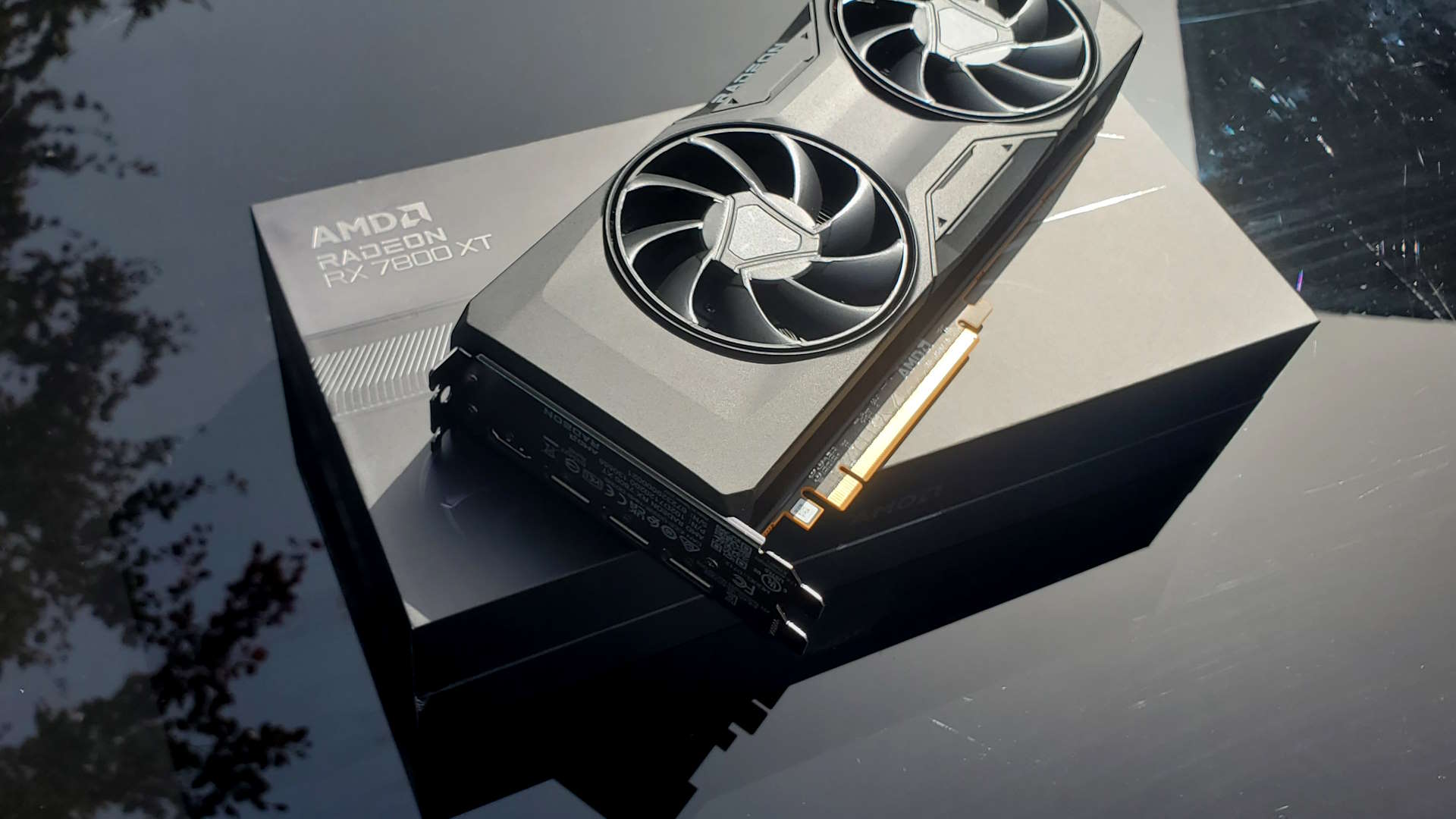Our Verdict
A very good graphics card for non ray-traced gaming, and the highest performance from a sub-$500 card. But with a multi-chip GPU that isn't moving the game forward, all it really has over the competition and its last-gen stablemate, is that lower price.
For
- Great 1440p performance for the money
- Full 16GB / 256-bit memory subsystem
- Quiet
Against
- Ray tracing performance still lacking
- Hotter and thirstier than Ada
- Not a huge improvement gen-on-gen
PC Gamer's got your back
How much value do you put on ray tracing as a PC gamer? That's got to be the question at the forefront of your mind if you're considering dropping $500 on an AMD Radeon RX 7800 XT. Because if you are 100% sold on ray tracing you probably need to consider whether you're actually willing to pay another $100 for the privilege of extra RT performance and drop the cash on the RTX 4070 instead.
If, however, you're convinced rasterised performance is the only GPU metric worth a damn in this topsy turvy world of PC gaming, then the RX 7800 XT is probably the best upper mid-range graphics card you can buy today.
Now, apologies for sounding too much like some class-obsessed Victorian English gent, creating strata after strata of card so I can jam the RX 7800 XT somewhere that makes sense. But when graphics card pricing is so ludicrously spread out—with the next Radeon up costing $800 at best—this $500 price point needs some sort of classification of its own.
It's not high-end any more, and it's not really enthusiast because that denotes some level of decent 4K performance. And for this amount of cash I'm certainly not calling it mainstream. Though it is essentially now the middle of the Radeon RDNA 3 line up, calling the RX 7800 XT mid-range doesn't sit well with me, either. We can then either go for lower high-end or upper mid-range, and I think I'll stick with the latter.
It can mix it with some of the best GPUs of this and the past generation.
So, that's where the RX 7800 XT lives, launching with a reference price of $499 (or £479 for the modern English gent) and with the sort of gaming performance that means it can mix it with some of the best GPUs of this and the past generation. Effectively now we have four graphics cards capable of very similar frame rates: the RX 7800 XT here, the RTX 4070, and then the RTX 3080 (which is pretty much end-of-life now) and RX 6800 XT from the previous generation.
That last one is maybe going to cause some confusion and perhaps consternation given that we've got two cards, a generation apart, essentially occupying the same GPU level and with the same performance. There's not a lot to separate the RX 6800 XT and RX 7800 XT, but we all know neither AMD nor Nvidia's latest GPU nomenclatures really make any kind of sense in relation to the last generation. Their tiering structures are just twisted layers of obfuscation and misdirection, and that always sets my teeth on edge trying to parse where a new GPU stacks up.
AMD Radeon RX 7800 XT verdict
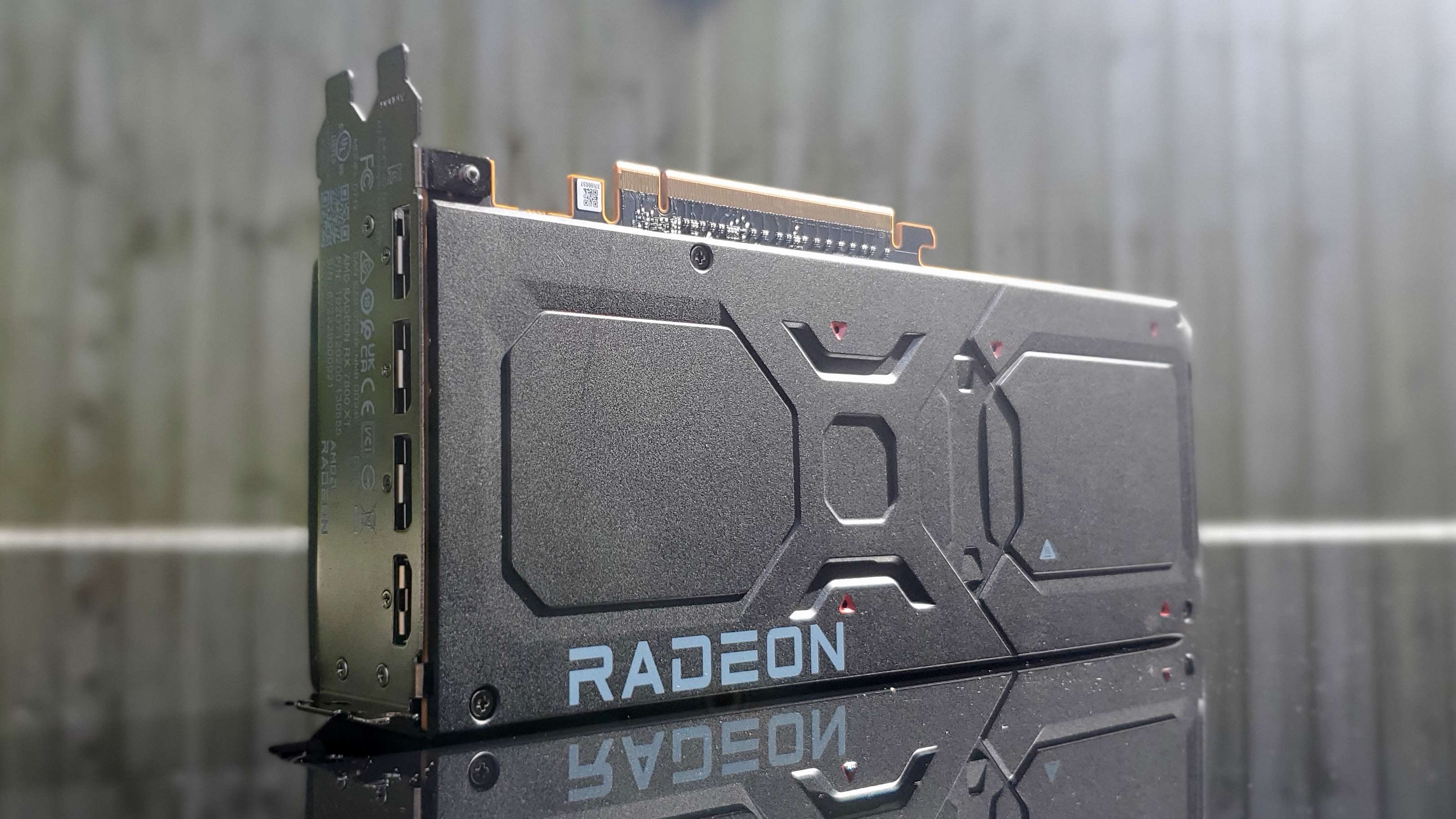
✅ You have a $500 budget: This is the best card in this price range right now, offering the standard gaming performance of two of the best GPUs from the last generation.
✅ You want the security blanket of 16GB VRAM: With a grand total memory capacity, and a 256-bit memory bus, the RX 7800 XT has a memory subsystem that will be ample for 1440p gaming for the forseeable future.
❌ You want ray tracing performance: AMD's RT acceleration is still a generation behind Nvidia's and with more games supporting it that might be a legitimate concern if you crave the peak lighting effects.
❌ You were hoping to upgrade your RX 6800-series card: Despite the chiplet technology, the game hasn't been moved on technologically from the same GPU tier of the previous Radeon generation.
The reductionist way of looking at the RX 7800 XT is that this new generation of Radeon GPU is delivering the sort of performance we had to pay $650 - $700 for last time around. But that's still a pretty tantalising way of looking at things. By offering frame rates akin to both the RX 6800 XT and RTX 3080 this price point is looking more potent than ever before.
And in terms of current-gen head-to-head with the RTX 4070—itself delivering RTX 3080 frame rates with benefits—you're getting straight raster performance in games that is broadly similar (and sometimes higher) but for $100 less.
That should all make it a very straightforward win for AMD, and the RX 7800 XT a card that ought to fly off the shelves. Were it just about the raw silicon, maybe that would be the end of it, but there is more to the modern GPU ecosystem than just stream processors these days, and it would be foolish not to talk about the competing feature sets and strengths of AMD and Nvidia's latest cards.
However much AMD would like you to know that it has improved the ray tracing performance of its RDNA 3 architecture, with silicon dedicated to accelerating the RT pretties, it's still a generation behind Nvidia, at best. When you throw heavily ray- traced games into the benchmarking mix, Nvidia's RTX 4070, and to a lesser extent the RTX 3080, takes the lead.
It's $100 cheaper, which is probably the real kicker.
But still the vast majority of the games you play today will be heavily skewed towards rasterised rendering performance. That's also a solid given across the board, put up against only the potential performance uplift something like either AMD's Fluid Motion Frames or Nvidia's Frame Generation can offer on a purely game-by-game basis.
Right now, that puts far more positives in the RX 7800 XT corner than the competing RTX 4070: It regularly wins out on straight raster frame rates, it has more video memory, which is a consistent theme of gaming today, and it has its own solid upscaling tech in FSR 2.2, with imminent updates on the way.
And it's $100 cheaper, which is probably the real kicker. If the two cards were closer in price then the Nvidia ecosystem—with the superior DLSS 3.5 and the magic of Frame Generation—would have more pull. But until Nvidia deigns to drop the price on its RTX 4070, too, the RX 7800 XT is looking like the best bet for most PC gamers right now.
Though we'll have to see how much traction this new Radeon card will have if it wants to improve AMD's GPU market share of course…
AMD Radeon RX 7800 XT specs
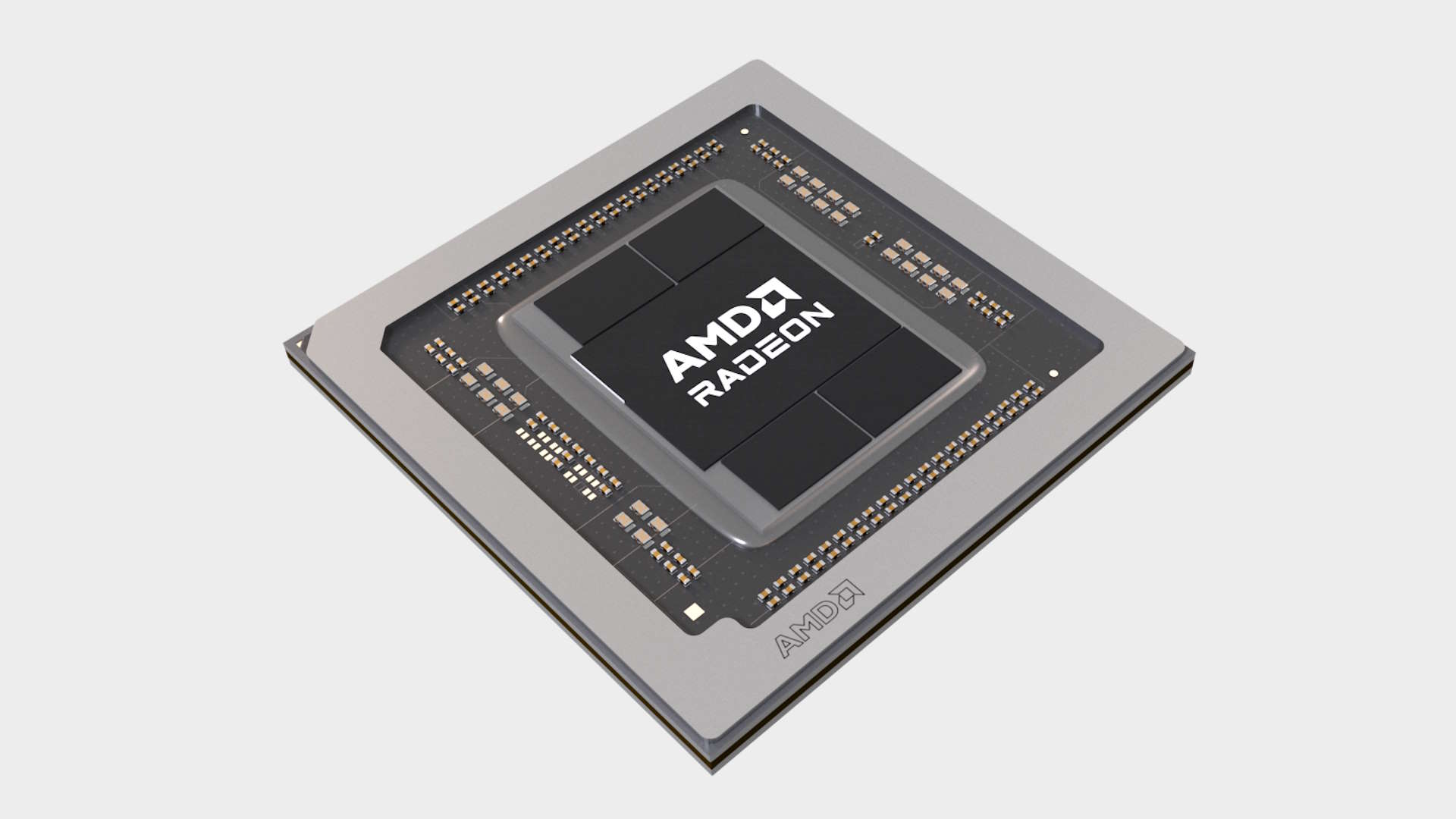
AMD hasn't gone into a whole lot of technical details for the Navi 32 GPU at the heart of both this RX 7800 XT and the slightly lower spec RX 7700 XT, but suffice to say this is the second chiplet graphics chip from AMD, which is a feat itself.
There has been much written about the rumoured struggles for AMD getting chiplet GPUs off the ground, with some reports suggesting it might even eschew the high-end with RDNA 4 and focus instead on mid-range monolithic chips instead. But AMD has still persevered with RDNA 3, and with four eminently functional multi-chip graphics cards launching in the first it's not a bad start for multi-chip GPUs.
Like the Navi 31 silicon inside the RX 7900 XTX and RX 7900 XT cards, AMD has taken the simple path of using a single Graphics Compute Die (GCD) rather than multiples to bump up the overall core or shader count. That was the method used so effectively on the CPU side, but getting multiple GPU components to talk coherently when faced with a game rendering task is a lot trickier than with standard number-crunching compute tasks.
| Header Cell - Column 0 | AMD Radeon RX 7800 XT | AMD Radeon RX 6800 XT |
|---|---|---|
| Architecture | RDNA 3 | RDNA 2 |
| Manufacturing process | 5nm GCD + 6nm MCD | 7nm |
| Transistors | 28.1 billion | 26.8 billion |
| Compute units | 60 | 72 |
| Shaders | 3840 | 4608 |
| ROPs | 96 | 64 |
| Infinity cache | 64MB | 128MB |
| Memory | 16GB GDDR6 | 16GB GDDR6 |
| Memory speed | 19.5 Gbps | 16Gbps |
| Memory bus | 256-bit | 256-bit |
| TBP | 263W | 300W |
| Launch price | $499 | $649 |
Our Jacob went in-depth with the RDNA 3 architecture in his initial AMD RX 7900 XTX review back at launch, and it's still a great reference if you want some extra nuance, but I'll run down the basics here.
Here we have the Navi 32 GCD, which is two thirds the size of that inside the Navi 31 chip at 200mm² vs. 300mm². Around that core chip are four Memory Cache Dies (MCD) which house the Infinity Cache, VRAM, and the memory bus.
AMD is still going with the same transistor node setup as with the RX 7900-series cards, which means a TSMC 5nm GCD and a TSMC 6nm MCD. The mission critical compute components are the ones on the cutting edge lithography, while the memory doesn't need to shrink down to the same extent, meaning that a 6nm node is absolutely fine for the MCD.
The GCD houses a total of 60 compute units (CUs), and therefore 3840 shaders, or stream processors; that's the same as the RX 6800 (non XT) from the previous generation. But the base architecture of RDNA 3, those CUs, have been enhanced to the tune of "approximately 17.4% architectural improvement clock-for-clock." So sayeth AMD, which sounds rather specific for an approximate measure.
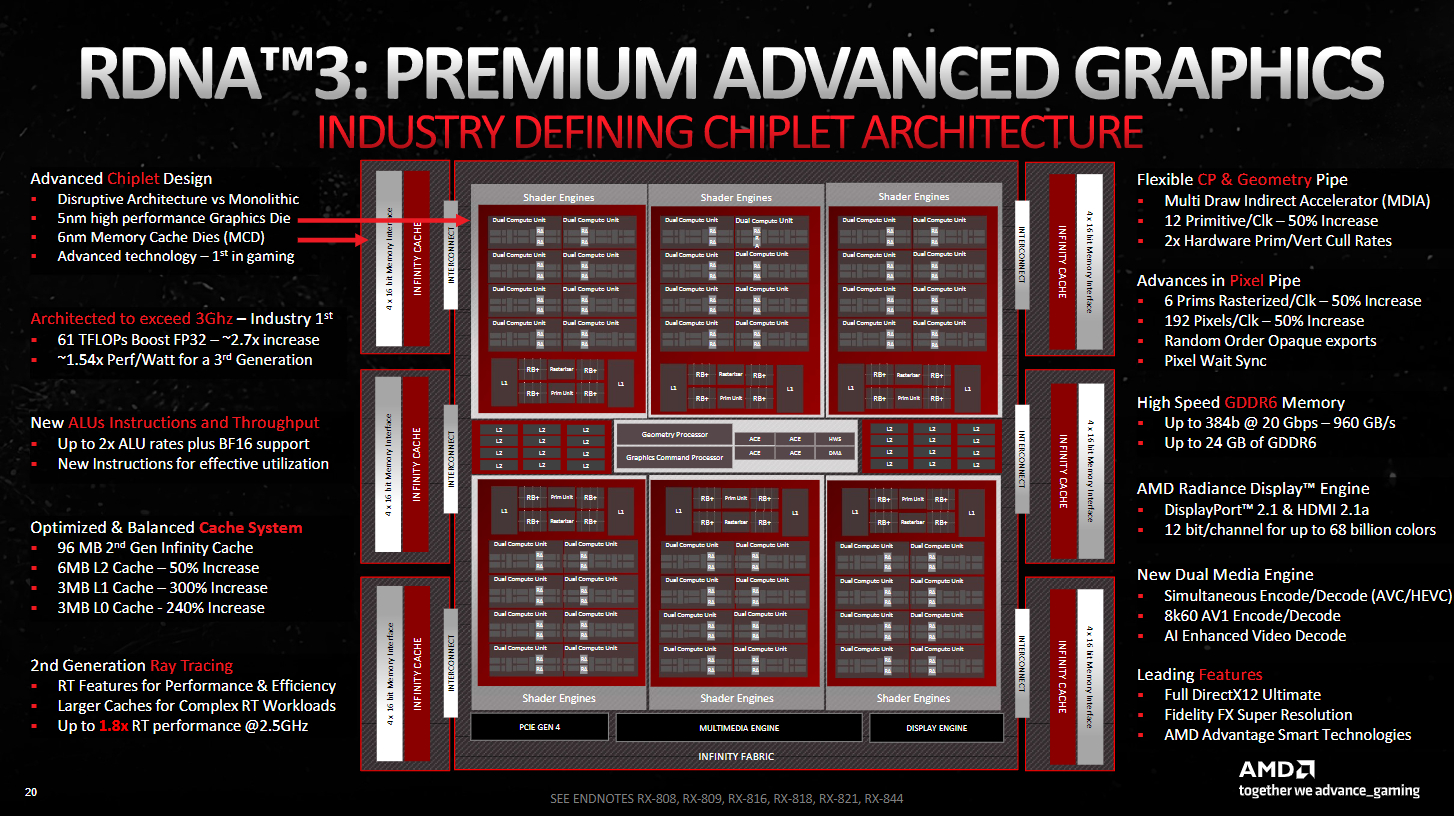
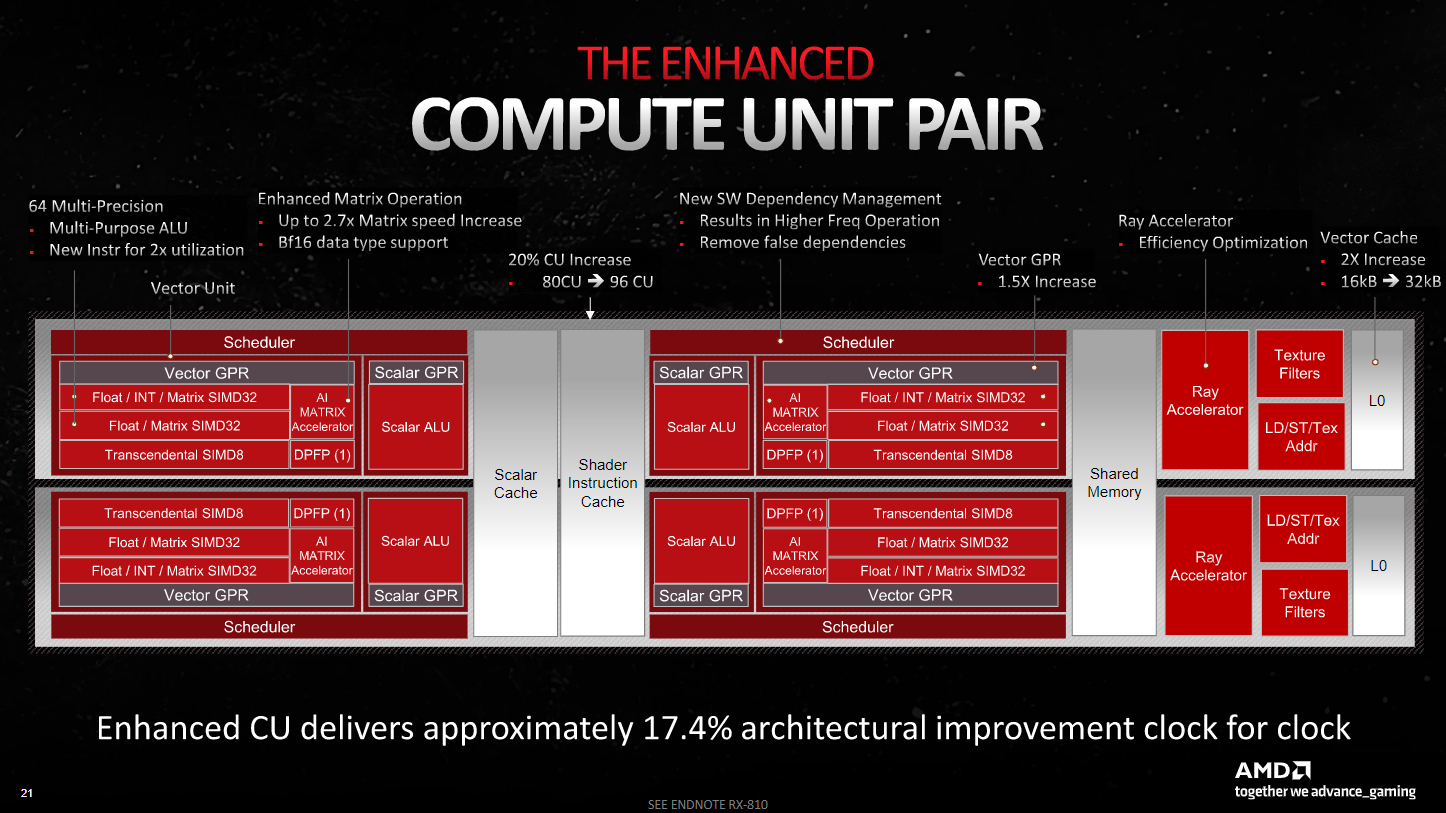
And in terms of those clocks the RX 7800 XT runs at a nominally higher frequency than either the RX 6800 or RX 6800 XT it's replacing. Though, notably, not as high as AMD initially promised for RDNA 3. There was effusive talk from AMD about RDNA 3 specifically being architected for 3GHz+ clock speeds around launch, but none of that has come to pass. And, in fact, the average clock speed in our Metro Exodus tests show the reference RX 7800 XT actually running slightly slower than the reference RX 6800 XT.
The generational progress, therefore, feels rather slight by direct comparison.
You are still getting 16GB of GDDR6 via those four MCDs, and also an aggregated 256-bit memory bus alongside them. That's pretty damned good for a $500 card, and it's a proper 16GB, too, not clam-shelled in some weird design à la the now-$449 RTX 4060 Ti and its meagre 128-bit bus. It's also higher clocked memory than the RDNA 2 cards, running at 19.5Gbps against the 16Gbps of the RX 6800-series.
That all helps bump the effective memory bandwidth, too, along with the 2nd Gen Infinity Cache, of which there is surprisingly less.
AMD Radeon RX 7800 XT benchmarks and performance
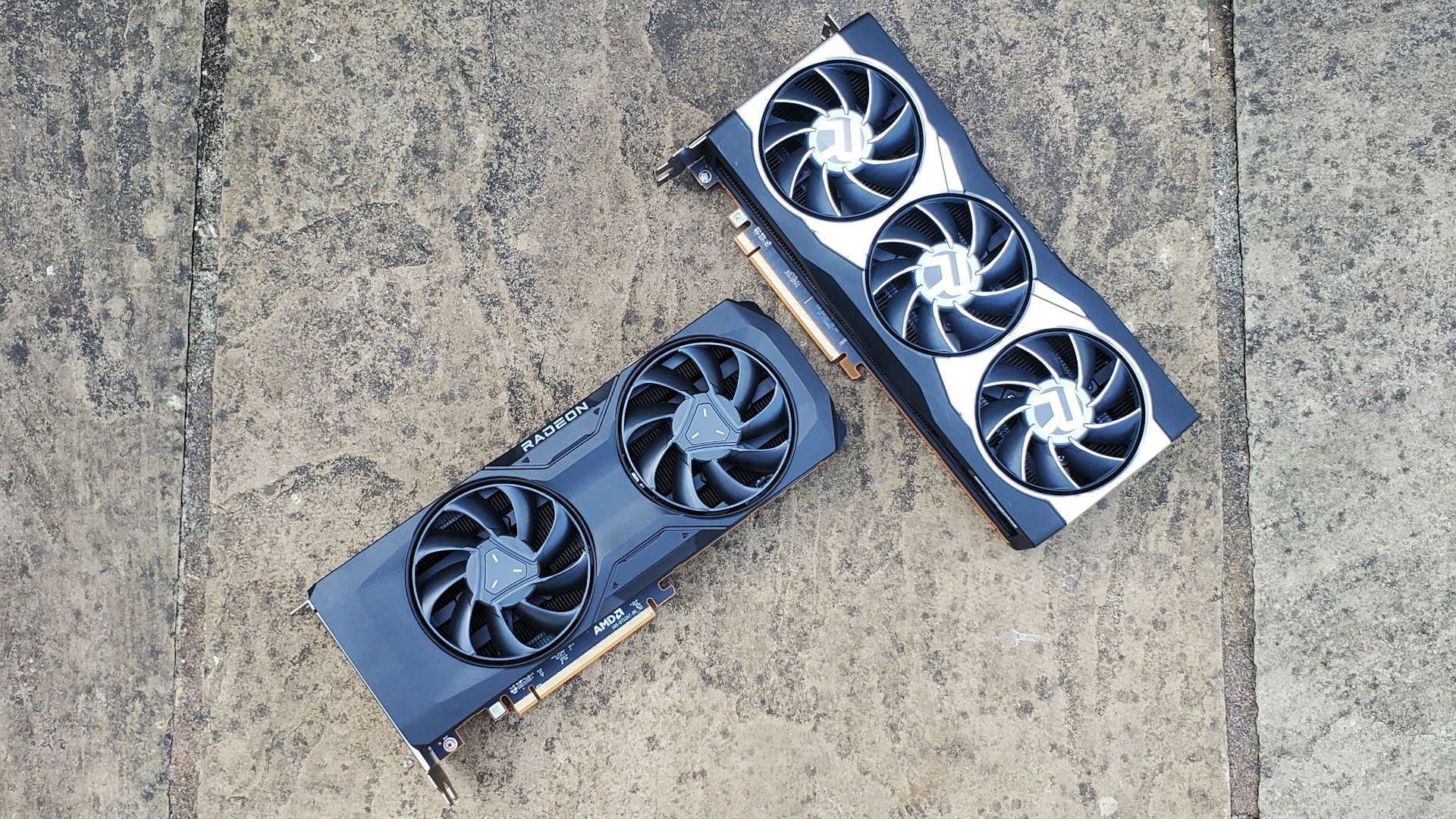
As you'd expect, and probably hope from a $500 graphics card, the RX 7800 XT makes an outstanding 1080p GPU. It's only in the uber-ray traced environs of Cyberpunk 2077 that it fails to top 60 fps at the tippiest of top graphics settings. Throughout the rest of our benchmark gauntlet the card is able to top 100 fps and actually mostly on towards the 144 fps you'd want for a high refresh rate monitor.
Synthetic gaming performance
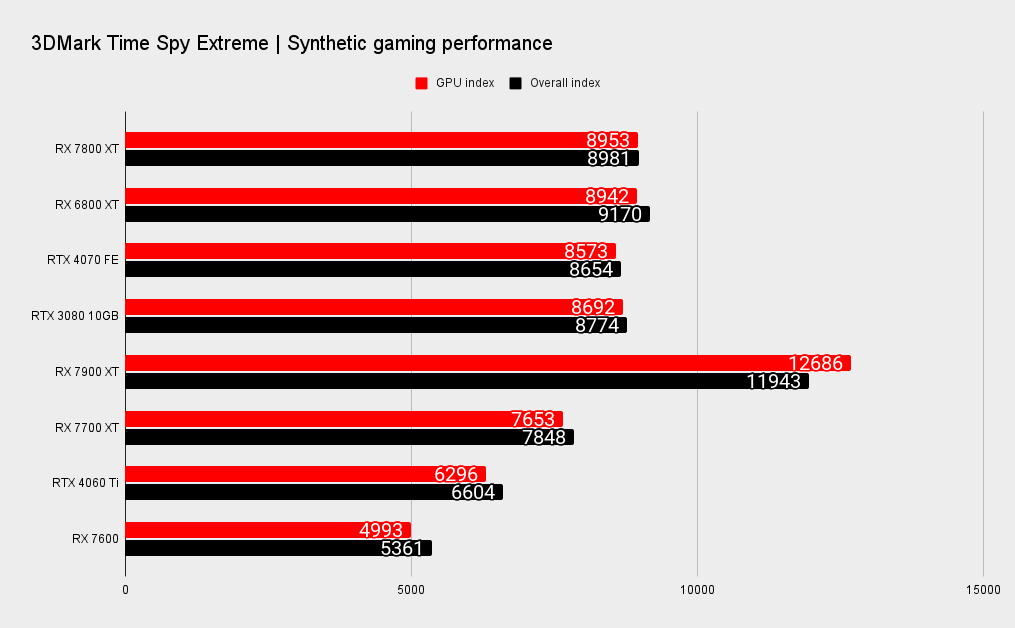
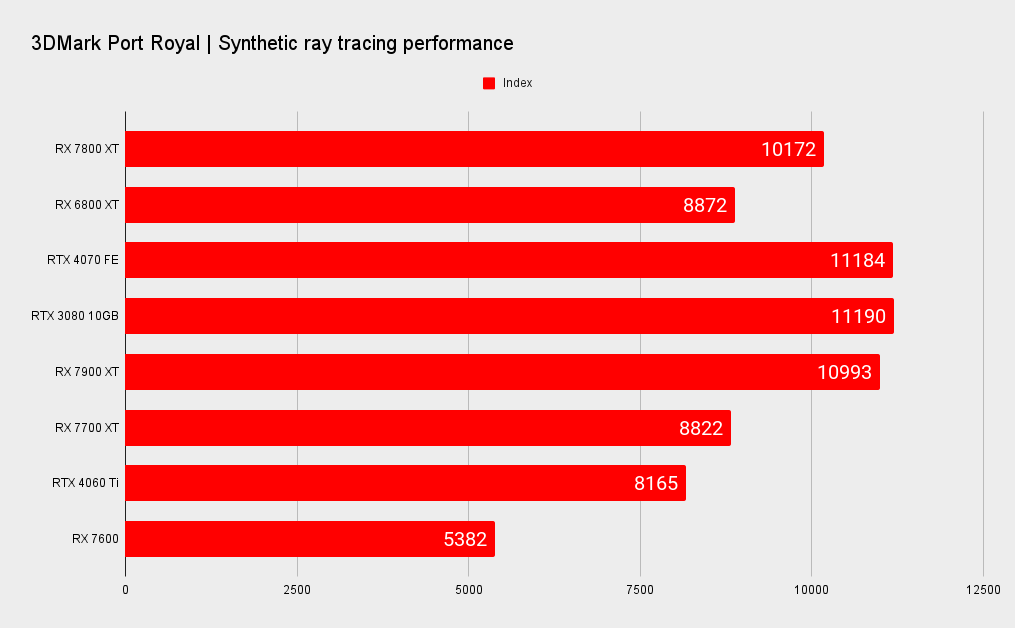
1080p gaming performance
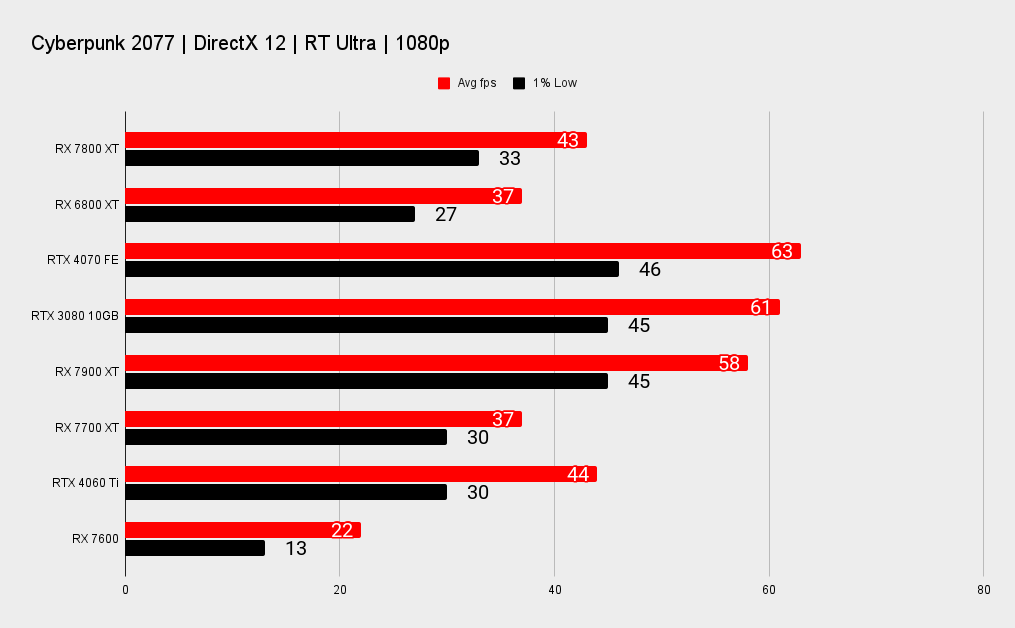

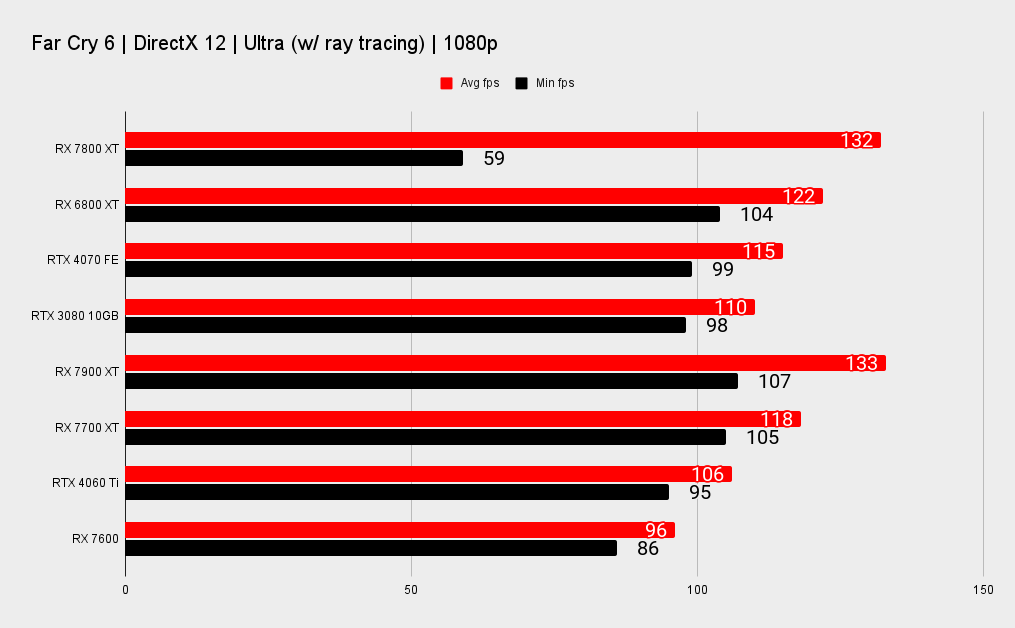
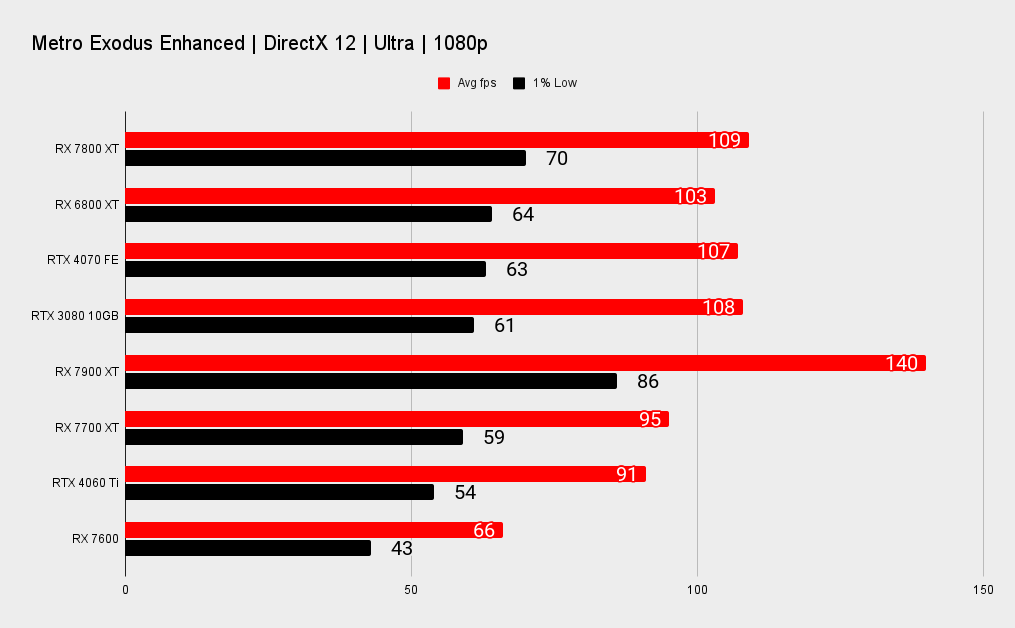
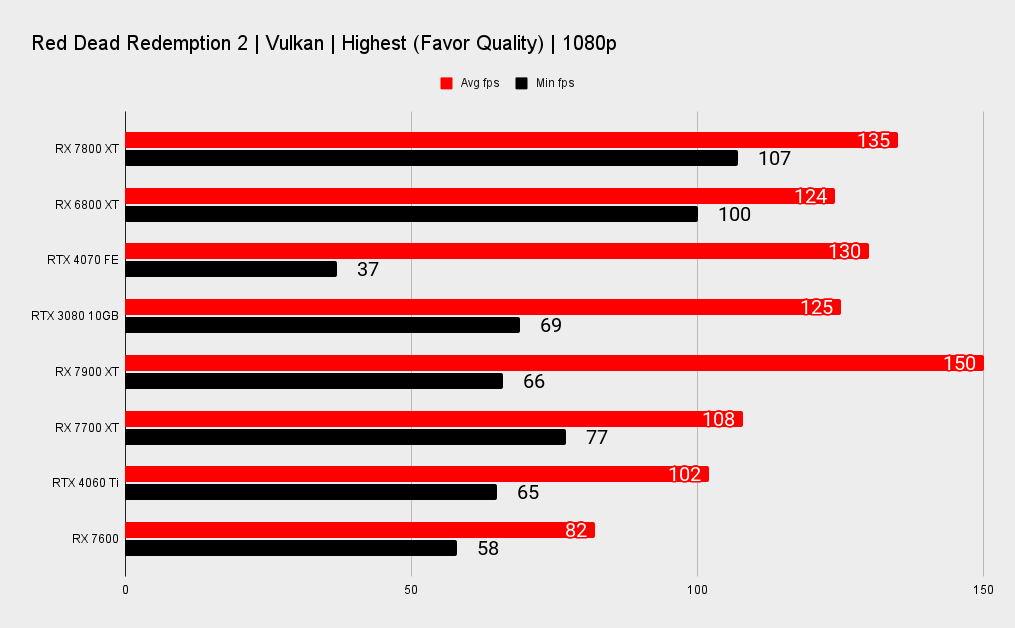

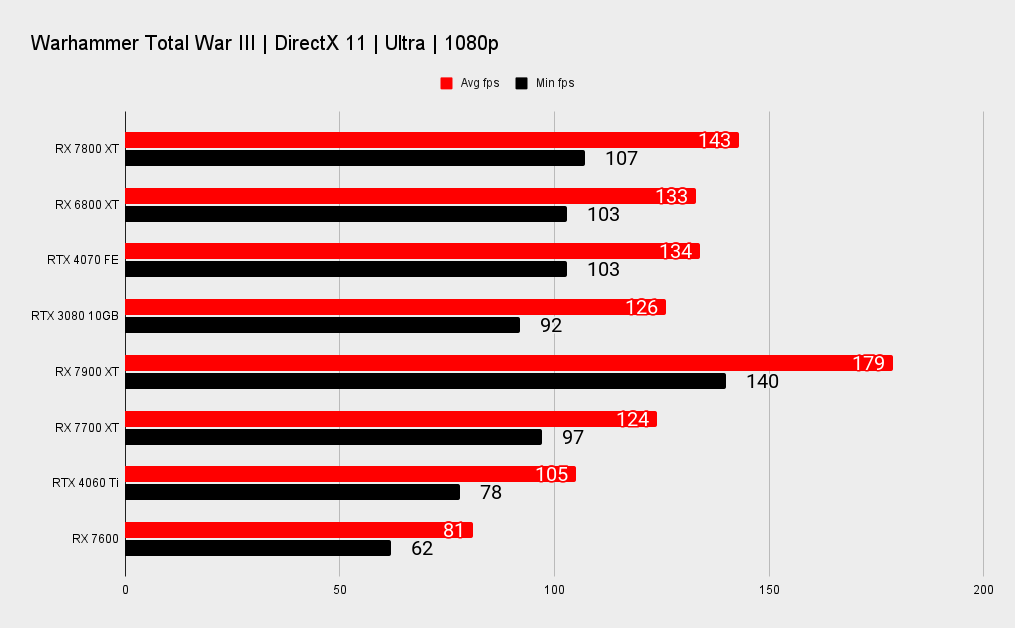
What AMD wants you to know, however, is that this is a 1440p graphics card, designed to top 60 fps in the latest titles at the top settings. And, honestly, it goes well beyond that outside of, again, that brutal Cyberpunk 2077 outlier. Those top four cards in the graphs—the RTX 3080, RTX 4070, RX 6800 XT, and RX 7800 XT—all trade blows throughout the benchmarks at this level and that just shows how close these cards are, and it's pleasing to see the RX 7800 XT as the cheapest one sometimes leading the way, too.
Even in F1 22 and Metro Exodus Enhanced Edition, where ray tracing is an important component of the high-end graphics settings, the RX 7800 XT gets across that 60 fps line with ease. But then in something like Far Cry 6 or Red Dead Redemption 2 you're looking beyond the 100 fps mark.
1440p gaming performance
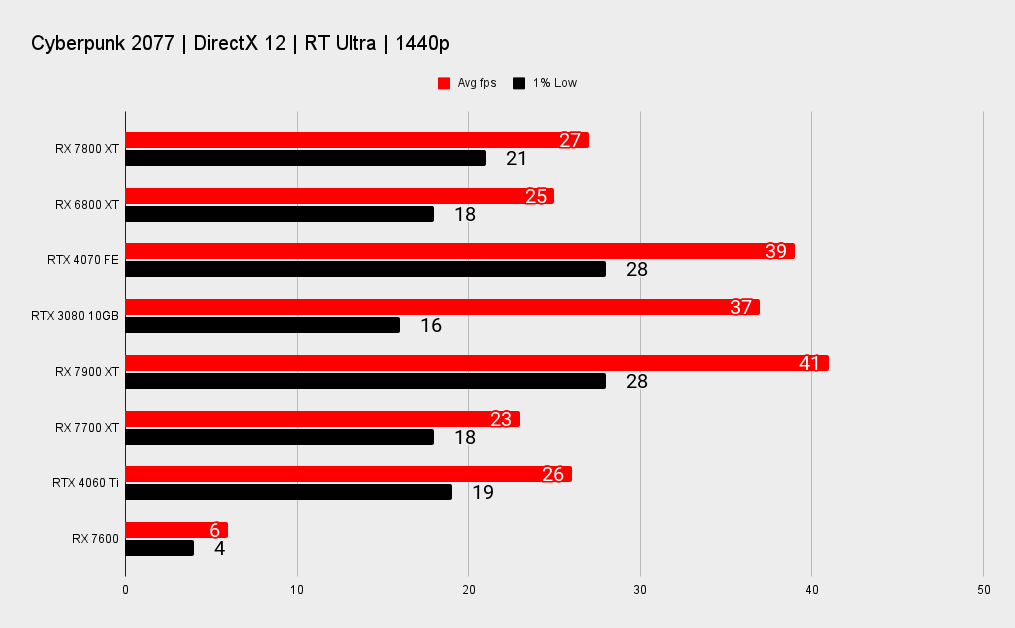
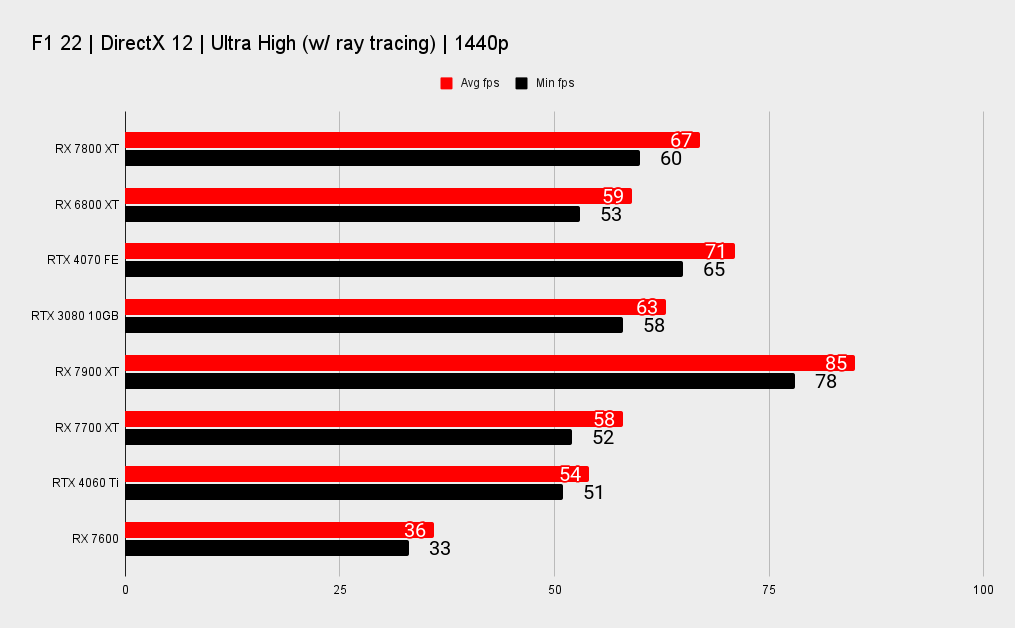
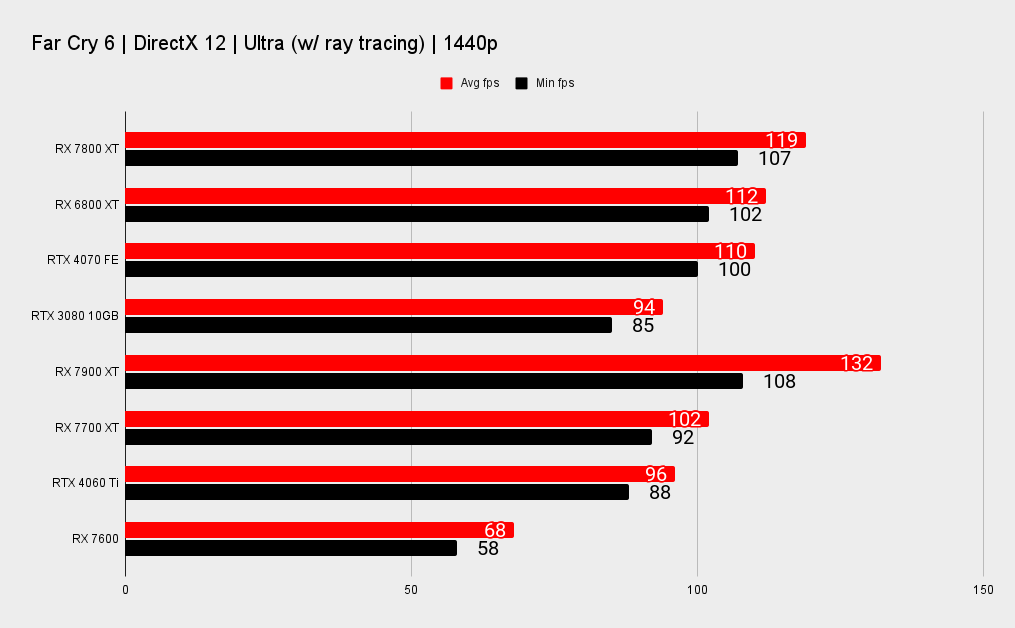

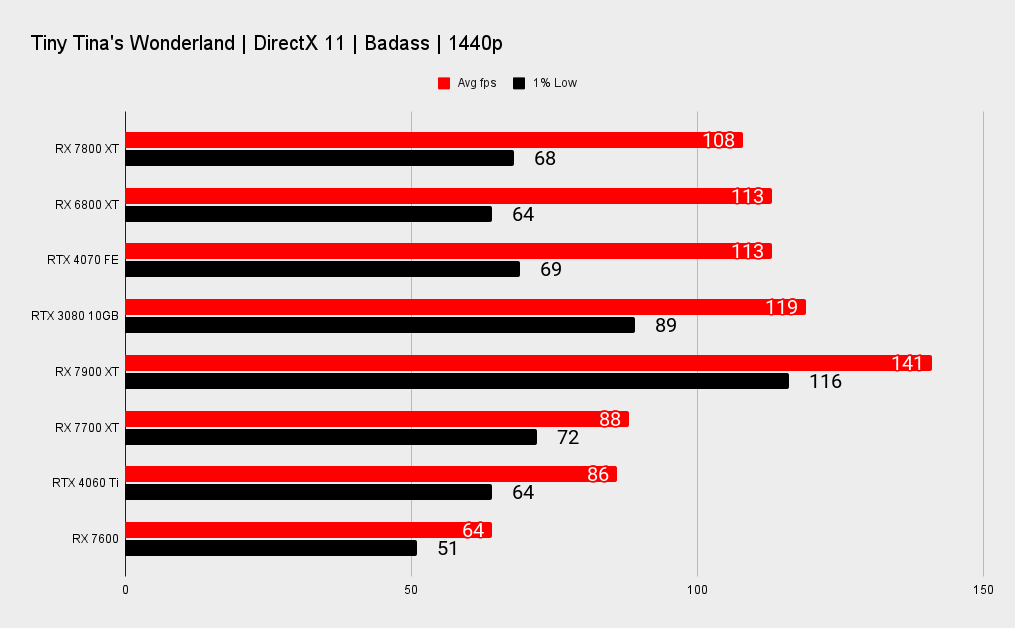
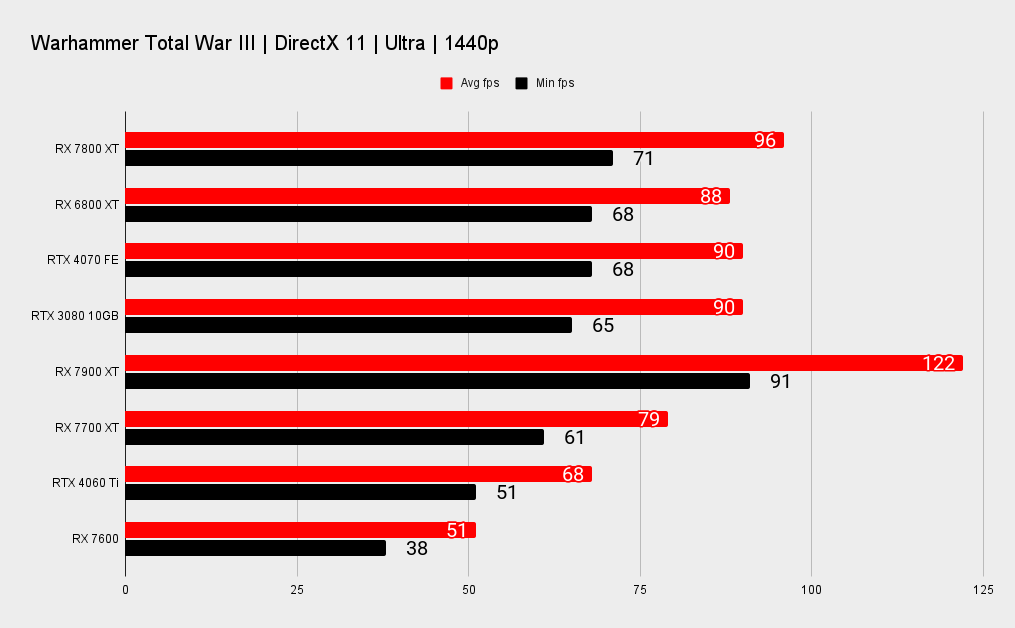
It's also important to note just how far ahead of the next one down the GeForce stack this Radeon GPU is. Compared with the RTX 4060 Ti, whether 8GB or 16GB, the RX 7800 XT is around 25% quicker for another 25% on the sticker price. And its relative performance against the RX 7700 XT is a nail in the coffin for its Navi 32-toting brethren. On average we saw a performance deficit of around 20%, but the price delta is a mere 10%.
That makes the RX 7700 XT's ludicrous $449 launch price far too close to the RX 7800 XT for it to be in any way relevant. Here's hoping it follows the RX 6700 XT's trajectory and drops to around $350 in the future, otherwise it really is a DOA GPU.
And all these numbers represent the RX 7800 XT's native performance, so are all just down to what the raw silicon is capable of without resorting to upscaling shenanigans for extra performance. Of course, you absolutely can do that with the RX 7800 XT, though it's less of a given that you'll enable FSR with AMD's implementation not faring too favourably compared with Nvidia's DLSS. That's especially true considering a lot of FSR-supporting games have still not been updated from the shaky first-gen version of the Radeon tech.
The RX 7800 XT even has some 4K gaming chops, as you would expect from a card that's offering performance right up there with the high-end of AMD's previous generation of GPUs. At this level you are going to need some upscaling to deal with any ray-traced lighting effects, however, as away from pure rasterised rendering you can see the RX 7800 XT start to chug with this many pixels on screen.
4K gaming performance

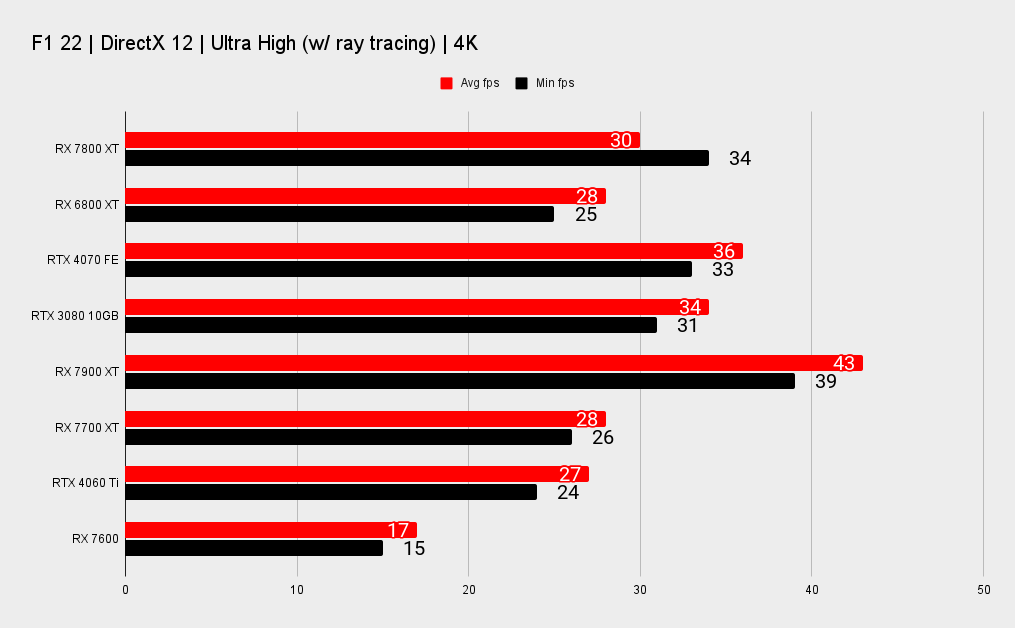

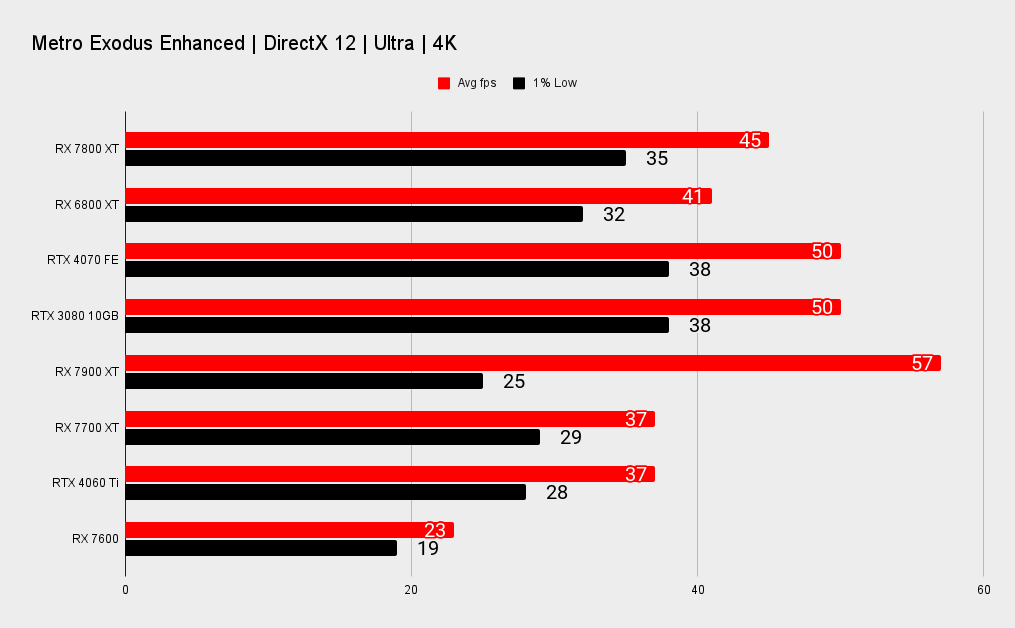
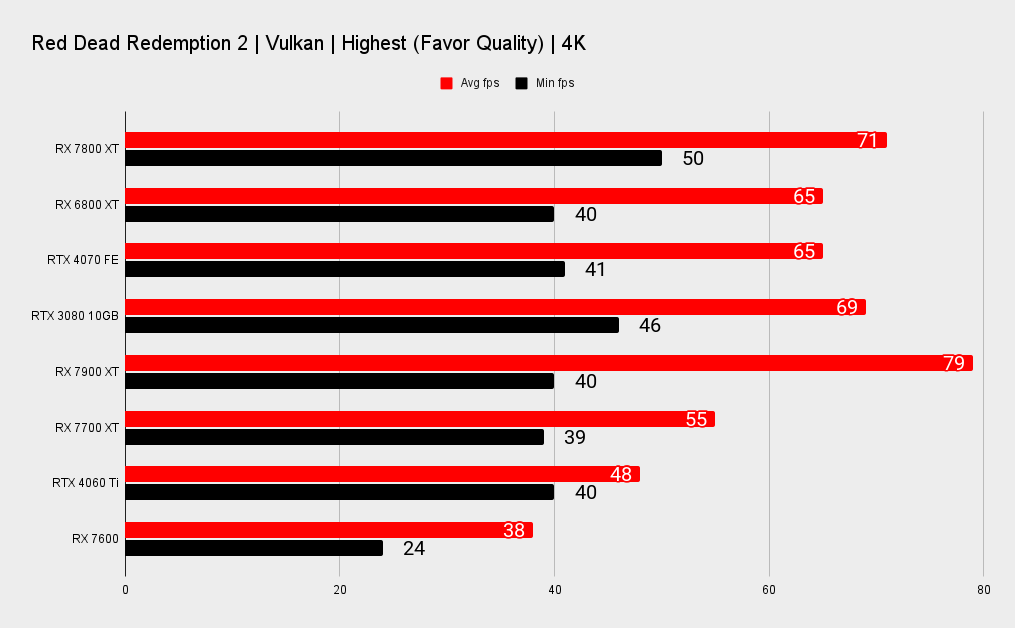
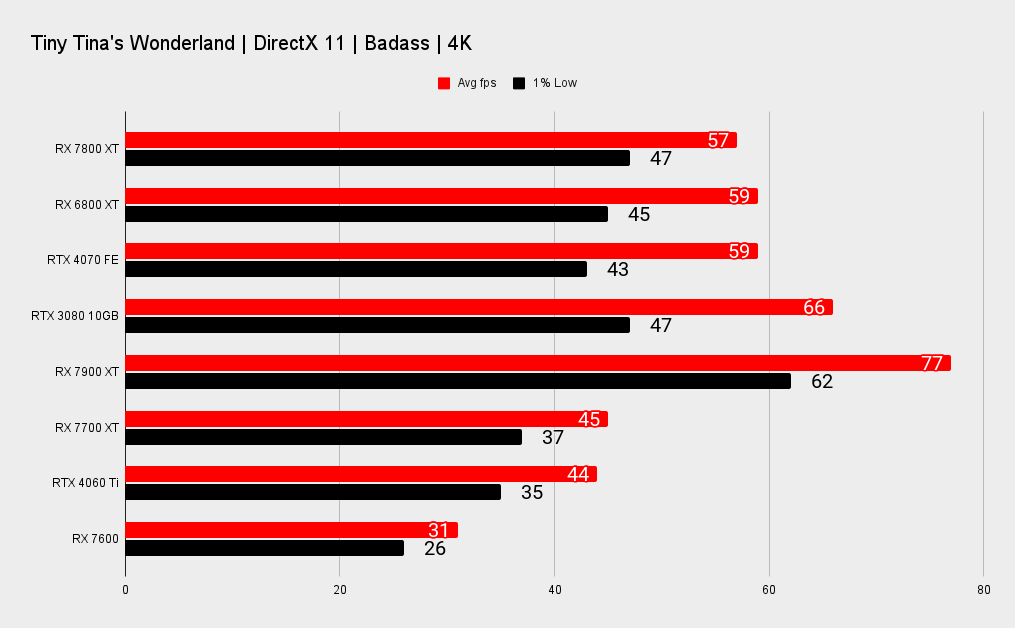
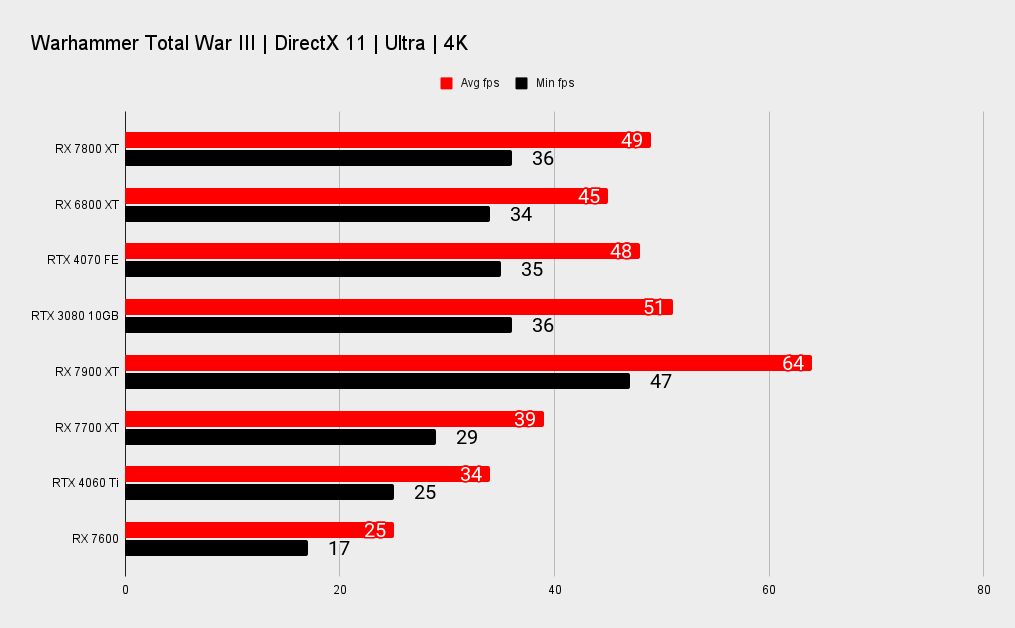
CPU: Intel Core i9 12900K
Motherboard: Asus ROG Z690 Maximus Hero
Cooler: Corsair H100i RGB
RAM: 32GB G.Skill Trident Z5 RGB DDR5-5600
Storage: 1TB WD Black SN850, 4TB Sabrent Rocket 4Q
PSU: Seasonic Prime TX 1600W
OS: Windows 11 22H2
Chassis: DimasTech Mini V2
Monitor: Dough Spectrum ES07D03
But, at this level, upscalers have a lot more image data to work with, and so your 4K upscaled experience is going to look a whole lot better than a 1080p upscaled one. I mean, that's just gross, especially on FSR 1.0. Have you tried upscaling on AMD cards with Baldur's Gate 3? Yurgh.
On the more holistic side of things, ie. temps and power draw, the advanced Nvidia Ada architecture is the clear winner. Its RTX 4070 is able to deliver the same general experience, with the extra ray tracing frosting, and still come in far less thirsty and far cooler as well. If we're talking about a better GPU architecture, Ada is probably that. Though I guess that's why Nvidia has opted to price it so high.
GPU performance

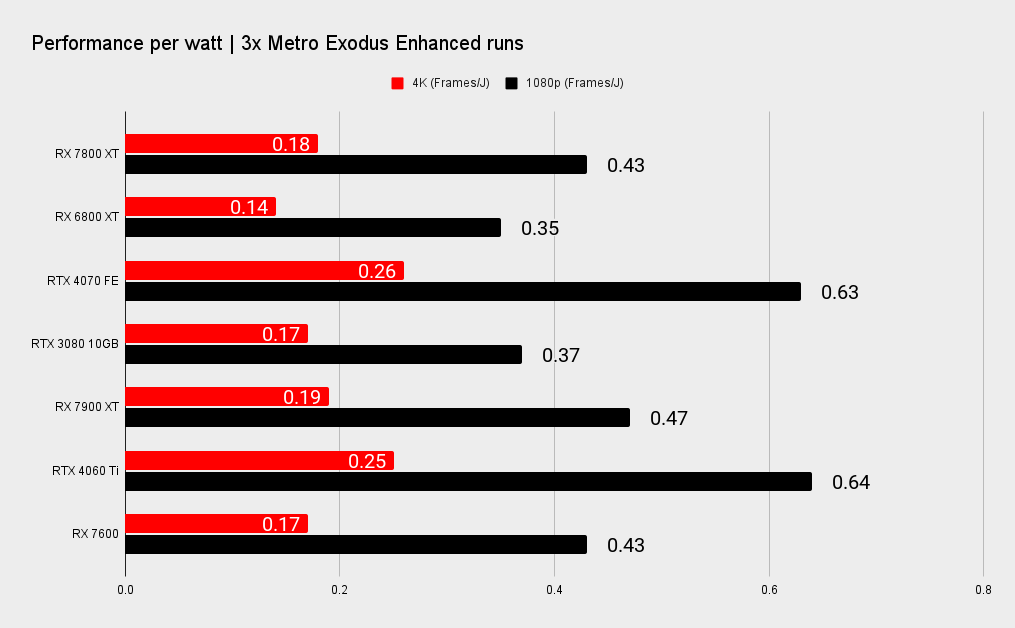
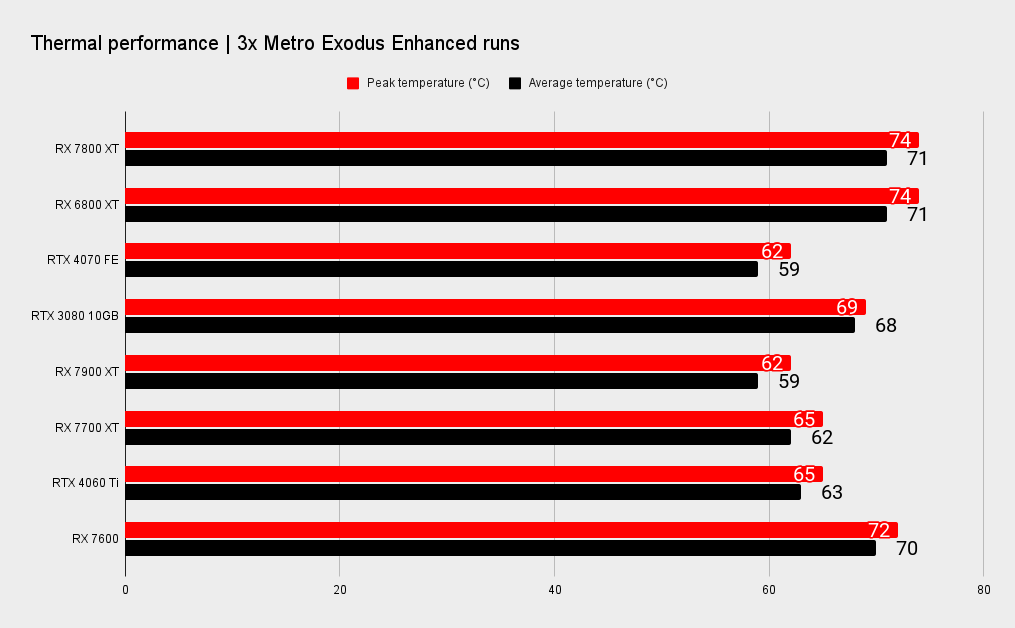
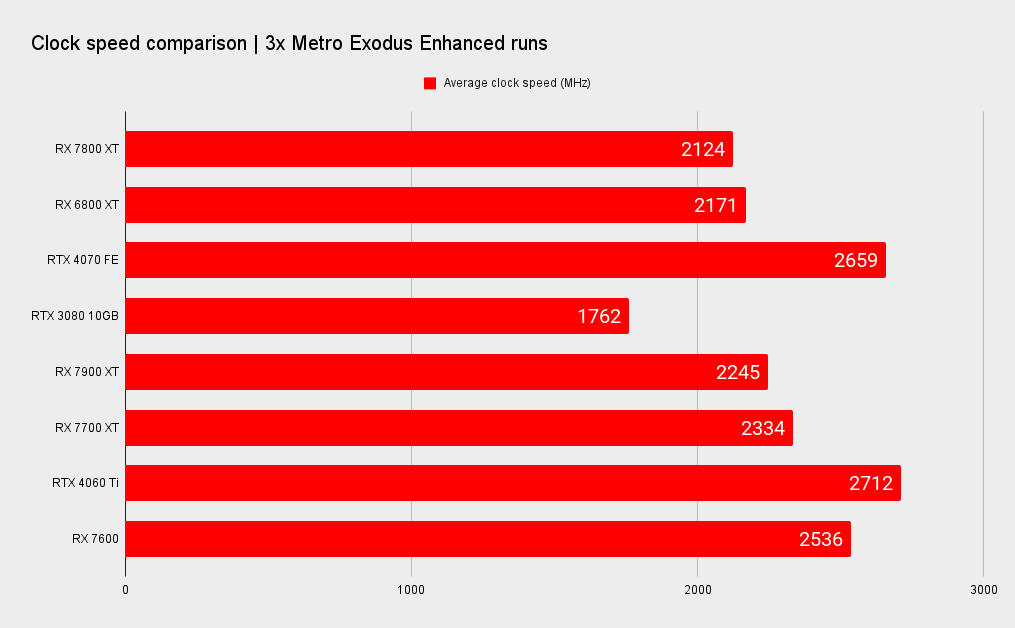
But the RX 7800 XT is still slightly less demanding on power than its RX 6800 XT forebear, and offers far more performance per watt. The issue is that it's just not a metric which reflects well on AMD in the straight up manufacturer dogfight. At 1080p the RTX 4070 offers 47% higher performance per watt compared with the RX 7800 XT.
AMD Radeon RX 7800 XT analysis

For anyone with a budget of $500 to spend, the RX 7800 XT is the only card on the block.
Where does the RX 7800 XT line up? Well, it lines up perfectly with the sort of graphics card launches we've come to expect from this faintly frustrating generation of GPUs. But the main takeaway has to be that you're getting effectively unprecedented performance from a graphics card with a launch price of $500.
Only effectively unprecedented because, until they completely sell out, you can bag an RX 6800 XT for $499 and you would scarcely notice the difference. That might be important if the RX 7800 XT proves hard to find on launch day.
It may be an upper mid-range card, but it's punching at a level with arguably the two best GPUs of the last generation in the RX 6800 XT and the RTX 3080. That also means it's roughly equivalent to the RTX 4070 in standard gaming terms—often quicker—with only games that specialise in the latest ray tracing effects giving a solid win to Nvidia.
And if you want that extra ray tracing performance, or the undoubtedly tempting prospect of DLSS 3.5 and Frame Generation, then you're going to have to pay for the privilege.
And it does all come down to pricing for this card, which is where the RX 7800 XT wins. It's not a cheap card by any means, $500 is a lot to spend on any component, but it is bringing down the price of this level of raster performance and a proper 16GB VRAM implementation. But this recommendation is true only for a reference-priced card—if you're looking at a third-party overclocked card for $550 or more I'd be far more tempted by the overall ecosystem behind the RTX 4070.

Technologically speaking, I'm less enthused by the card. Sure, the fact the chiplet technology is functioning at all, let alone delivering such consistently good performance, is a big tick for AMD's engineers. But, like practically all the graphics cards of this generation, it feels like we're getting the bare minimum, just enough.
Right now, even with its relatively cut-down specs lagging behind the RX 6800 XT, the RX 7800 XT still performs as well, but for a significant reduction in price. That's important, because if it had come in at $650, performing this far below the likes of the RX 7900 XT at $770, it would have been a disaster. And had AMD been able to spec the Navi 32 GCD at the same level as the 72 CUs of the RX 6800 XT we would have had a far more exciting GPU on our hands.
But that just enough is still enough. For anyone with a budget of $500 to spend on the latest graphics cards, the reference-priced RX 7800 XT is the only card on the block. Even now the 16GB RTX 4060 Ti has had a price cut down to $449, I would still recommend opting for this Radeon card instead.
A very good graphics card for non ray-traced gaming, and the highest performance from a sub-$500 card. But with a multi-chip GPU that isn't moving the game forward, all it really has over the competition and its last-gen stablemate, is that lower price.

Dave has been gaming since the days of Zaxxon and Lady Bug on the Colecovision, and code books for the Commodore Vic 20 (Death Race 2000!). He built his first gaming PC at the tender age of 16, and finally finished bug-fixing the Cyrix-based system around a year later. When he dropped it out of the window. He first started writing for Official PlayStation Magazine and Xbox World many decades ago, then moved onto PC Format full-time, then PC Gamer, TechRadar, and T3 among others. Now he's back, writing about the nightmarish graphics card market, CPUs with more cores than sense, gaming laptops hotter than the sun, and SSDs more capacious than a Cybertruck.
